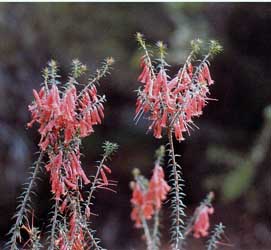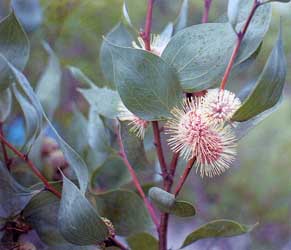
Throughout the 19th and 20th century, through the efforts of people such as William Guilfoyle, Walter Burley Griffin, Edna Walling, Ellis Stones and Gordon Ford, Australia has developed its own unique style of gardening - the 'Australian Bush Garden'. Not all gardens by any means are built in this style, but those which are, are uniquely Australian. This natural bush style is a very informal type of garden which attempts to recreate as much as possible the naturally occurring landscapes of the Australian bush.
Gordon Ford
Gordon Ford was one of Australia’s great landscape designers. Born in 1918, he was educated in art and philosophy at Melbourne University. He later lived in Eltham, Victoria, and worked and trained with Ellis Stones who was another major influence on natural landscape styles. Ford loved to use rocks, massive boulders, and water in his designs. He produced lakes and waterfalls - believing them to be essential to the natural Australian garden. As well as suburban garden designs, Ford also worked on industrial projects and works for major institutions such as Monash University. Gordon Ford died at the age of 81.
Ferdinand von Mueller (Baron)
Ferdinand Jakob Heinrich von Mueller (1825-1896) along with his two sisters arrived in Adelaide in December 1847. He was a qualified pharmacist but also an enthusiastic botanist with a PhD. His doctoral thesis surveyed the flora of Schleswig in his home country of Germany.
Upon his arrival in Adelaide he continued to work as a pharmacist despite a short foray into farming. However, the vast majority of his time was spent studying the flora of South Australia from Mount Gambier to the Flinders Ranges and Lake Torrens. His findings were published in papers in both London and Germany.
In 1852, von Mueller moved to Melbourne as the government botanist appointed by Charles La Trobe. Official estimates show that he collected specimens of over half the indigenous flora of Victoria, often in previously unexplored and hostile regions including the Victorian Alps, where he reported that he investigated the flora of the area in its entirety. He also identified species within Victoria that were earlier found in Tasmania, added new genera to the flora of Australia, and reported on the possible medicinal value of some Australian native plants.
Between 1855 and 1857, with a leave of absence from his post as director of the Melbourne Botanic Gardens, he was appointed the botanist for the North Australian Exploring Expedition. They travelled some 8000 kilometres and spent 16 months exploring the interior regions of Australia, from the mouth of the Victoria River to its source, through the Great Sandy Desert to Lake Gregory (A.C. Gregory was the expedition’s leader), then overland to Moreton Bay. During this expedition von Mueller observed 2000 species of which 800 were newly discovered.
Returning to Melbourne in 1857, he returned to his post as Director of the Botanic Gardens and began the construction of the herbarium to which he contributed his own extensive collection. His work 'Fragmenta Phytographiae Australiae' was published between1858-1882 in twelve parts.
Walter Burley Griffin
Walter Burley Griffin (architect and landscape architect) was born in Chicago USA in 1876 and died in India in 1937 from complications following an operation. He was instrumental in designing many notable landscapes and buildings in the USA. In 1912 he won an international competition for his design of Canberra (capital city of Australia). His wife Marion, also an architect, produced the beautifully constructed drawings that were entered into the competition. In 1914, he along with Marion arrived in Canberra but it was many years later, and after much controversy, before his plans for the city were implemented. It took even longer for his plans for the lakes within the city to be put into practice – they were not completed until 1965.
Burley Griffin used the existing topography of the land and drew on the influence of the natural surroundings to design his work. Canberra is a quintessentially ‘Australian’ city with its emphasis on native plantings.
 William Guilfoyle
William Guilfoyle
William Robert Guilfoyle (1840-1912) came to Australia as a young boy with his nurseryman father along with his mother in 1849. His father opened a nursery in Redfern (Sydney) and later another at Double Bay. Guilfoyle studied at Lyndhurst College, Glebe after initially being privately tutored by his uncle.
After several years of scientific expeditions throughout the South Seas on the HMS Challenger, and later growing tobacco and sugar on his father’s land at Tweed, he was appointed in 1873 as curator of the Royal Botanic Gardens in Melbourne, Victoria (founded by Charles La Trobe). Guilfoyle brought design and aesthetics to the gardens (after the more scientific approaches by earlier curators Ferdinand von Mueller and Dallachy).
Guilfoyle drew his inspiration from the tropical gardens of his South Sea expeditions and proceeded to remodel as well as extend the gardens to include native fern gullies, sweeping lawns, vistas, temples, follies, hermitages and pagodas. He also further expanded the planting scheme to include native plants as well as many more exotics. The gardens were increased by another 40 hectares under his direction in the typical English Landscape style. He also had an influence on the planting that surrounds the creek that runs through the Fitzroy Gardens.
Guilfoyle wrote several educational books and pamphlets between 1874 and the early twentieth century including the 'First Book of Australian Botany' (1874) which was later revised as 'Australian Botany Especially Designed for the Use of Schools' (1878); 'The A.B.C. of Botany' (1880); and 'Australian Plants' (1911).